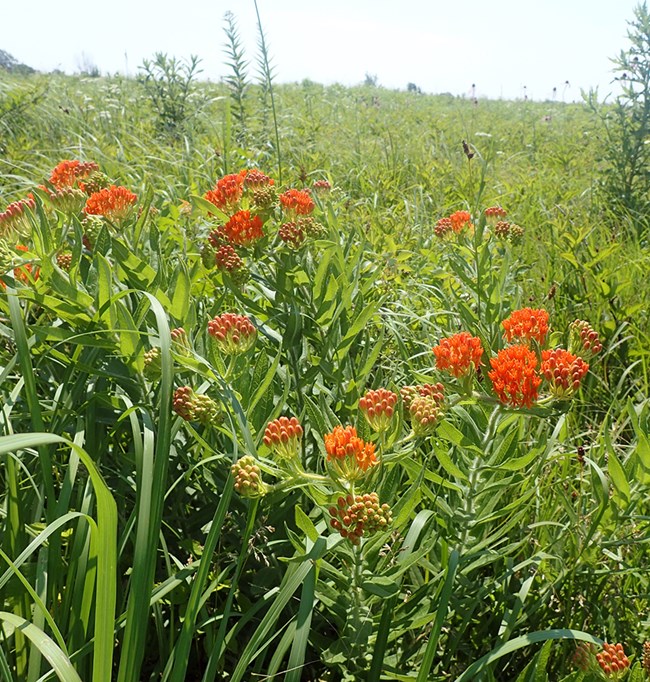Last updated: May 26, 2023
Article
Prairie Community Monitoring at George Washington Carver National Monument

NPS
Park Prairies
George Washington Carver National Monument (NM) was established to preserve the farm where Dr. Carver (a renowned scientist, teacher, and conservationist) spent his childhood. Prairies and savannas were common in southwestern Missouri when Carver was a boy in the 1800s. Extensive farming and fire suppression eliminated much of the tallgrass prairie that covered about a third of Missouri prior to European settlement. Today, less than 1% of Missouri's original tallgrass prairie remains. While these original prairies do not exist at the park, a tallgrass prairie reconstruction began in 1985.
The Heartland Inventory and Monitoring (I&M) Network monitors the park's restored prairies to understand how they may be changing over time. In the past, natural fire, grazing, and drought preserved tallgrass prairie ecosystems. Today, the park uses prescribed fire, mowing, and herbicides to maintain the restored prairie and its important ecosystem functions. These treatments stimulate growth in native grassland plants and keep trees from establishing and converting the prairie into savanna or woodland. Abundant grasses and a wide variety of forbs (herbaceous flowering plants) are essential for a healthy tallgrass prairie.

NPS
Plant Monitoring
Heartland I&M Network scientists have been monitoring prairie plants in 7 sites across George Washington Carver NM since 2004. We monitored these prairie sites in 2004, 2005, 2008, 2012, 2016, and 2020. We collect information on climate, fire history, how many plant species are present, how much ground area each species covers (a measure called plant cover that is an estimate of abundance), how much of the ground is covered by plant material or rocks, and how many tree seedlings and saplings there are in the prairie. These measurements allow us to assess the current condition of the prairies and to track them over time so the park can evaluate how well their management actions are working to maintain the restored tallgrass prairies.

NPS
Prairie Plants 2004–2020
The prairie plant community is relatively diverse even with recent increases in tree seedlings and small saplings. Despite these increases, there are no overstory trees in the park prairies. Prairie plant diversity was similar over the years but there were fewer species in 2012, an exceptionally dry year. The 2012 drought may have affected the abundance of some plants as well. Rainfall at the park was mostly below normal since 2000 and was below normal for all but one of the six years we monitored the prairies.
Since 2012, the park has focused on removal of two sumac species (Rhus copallinum and Rhus glabra) using fire and invasive species management. This has been very successful in decreasing the amount of sumac, but blackberry species (Rubus spp.) seem to be replacing sumac in some sites and other nonnative species appear to be slowly increasing. We detected a decline in native grasses since 2004 that may be explained by drought, increases in tree seedlings and saplings, or a change in our monitoring procedures. Collecting more data will help us answer this question. Active management of the prairie will always be important for maintaining native species diversity and the open prairie structure.

NPS
Did You Know?
Big bluestem (Andropogon gerardii) is a warm-season bunchgrass that grows to a height of 4 to 8 feet. It is a matrix grass (a dominant grass) in tallgrass prairie and also provides critical habitat for quail and ground-nesting birds. On the restored prairie at George Washington Carver NM, big bluestem had an average cover of 15 to 25% on monitoring plots (an abundance estimate) and it was similar over time.
Drought, temperature, and competition from other species, particularly nonnative grasses, can affect the abundance of big bluestem in prairies. One climate change model shows the range of this species shifting northeasterly away from Missouri. We monitor this species to understand how it varies naturally from year-to-year so we can compare that information with future data on big bluestem as the climate changes.
For More Information
Read the Full Report.Check back later for updates. We will update this page each year as we gather more information.
Visit the Heartland Inventory & Monitoring Network website.
